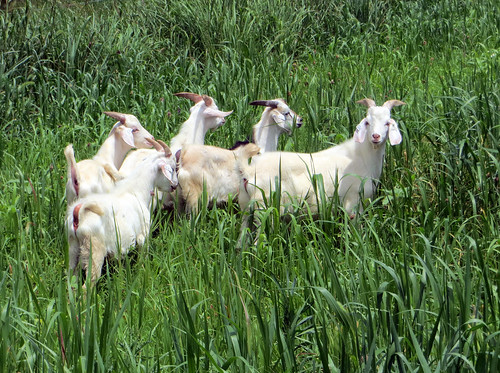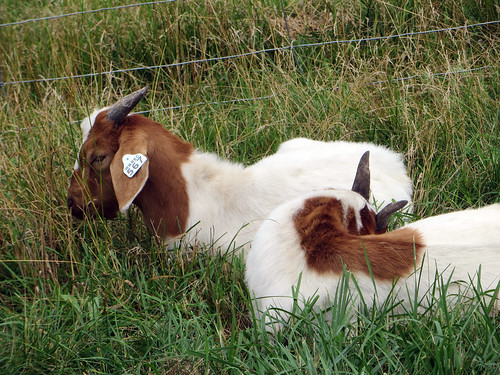Eighty-four (84) bucks started the 2015 Western Maryland Pasture-Based Meat Goat Performance Test. Approximately half of the bucks were worked on June 24; the other half were worked on June 26.
Upon arrival, the bucks stood in a foot bath containing zinc sulfate. They were weighed by Jeff Semler. FAMACHA®, body condition, coat condition, dag, and fecal consistency scores were determined by Susan Schoenian. To make sure the goats started the test equally and "free" from parasites, they were sequentially dewormed (orally) with albendazole (Valbazen®), moxidectin (Cydectin®), and levamisole (Prohibit®), according to the dosage recommendations of the American Consortium for Small Ruminant Parasite Control (ACSRPC).
A test tag was inserted in the opposite ear as the scrapie tag. An individual fecal sample was collected from each buck. A pooled fecal sample was collected by obtaining fecal material from each consignment. Fecal samples were sent to Virginia State University of analysis.
This year's bucks ranged in weight from 32.6 to 71.8 lbs. and averaged 49.0 lbs ± 8.4. The median weight was 47.8 lbs. The bucks are approximately five pounds heavier than last year.
For this year's test bucks, FAMACHA© scores ranged from 1 to 4 and averaged 2.2 ± 0.7. The median score was 2.0. Last year, FAMACHA© scores averaged 1.6 ± 0.6 on the bucks' day of arrival. The median score was also 2.0. FAMACHA© scores are a measure of anemia, the primary symptom of Haemonchosis (barber pole worm infection). High FAMACHA© scores (4,5) are indicative of anemia and the need for deworming.
Body condition is one of the criteria of the Five Point Check©. Body condition scores (BCSs) range from 1 to 5, where 1 is emaciated and 5 is obese. For this year's test bucks, body condition scores ranged from 1.5 to 3 and averaged 2.4 ± 0.3. The median body condition score was 2.5.
In the Five Point Check©, coat condition replaces the nose check point (used in sheep to assess nasal bots). Coat condition scores range from 1 to 3, with 2 being average. In this year's test bucks, coat condition scores ranged from 1.5 to 3 and averaged 2.1 ± 0.2. The median coat condition score was 2.
Dag scores are part of the Five Point Check©. Dag scores reflect the amount of fecal soiling on the backside of the animal and are a measure of past or current scouring (diarrhea). Scores range from 0 to 5, with 0 being no fecal soiling and 5 being excessive soiling. In this year's test bucks, dag scores ranged from 0 to 2 and averaged 0 ± 0.2. Only two goats had positive dag scores. The median dag score was 0.
Fecal consistency (FC) scores are not part of the Five Point Check©, but are assessed to determine if the goat is currently scouring. Scores range from 1 to 4, with 4 being normal feces (solid pellets) and 1 being liquid feces (diarrhea) For this year's test goats, fecal consistency scores ranged from 2 to 4 and averaged 3.9 ± 0.4, as a few goats had soft stools. The median score was 4.0.
The first 13 days of the test will serve as an adjustment period. The first data will be collected on July 9. The goats will be weighed on consecutive days to determine starting weights.
The goats will spend the first half of the test grazing warm season annuals: dwarf pearl millet + sunn hemp. The paddocks also have plenty of weeds to offer the goat a variety of plants for grazing. Throughout the test, the goats will be fed pelleted soy hulls daily. They will be started on the hulls slowly. The amount of hulls will be gradually increased until it reaches 0.75 lbs. per head per day.
Download June 26 (d -13) Report
Upon arrival, the bucks stood in a foot bath containing zinc sulfate. They were weighed by Jeff Semler. FAMACHA®, body condition, coat condition, dag, and fecal consistency scores were determined by Susan Schoenian. To make sure the goats started the test equally and "free" from parasites, they were sequentially dewormed (orally) with albendazole (Valbazen®), moxidectin (Cydectin®), and levamisole (Prohibit®), according to the dosage recommendations of the American Consortium for Small Ruminant Parasite Control (ACSRPC).
 |
| A sample of this year's test bucks |
A test tag was inserted in the opposite ear as the scrapie tag. An individual fecal sample was collected from each buck. A pooled fecal sample was collected by obtaining fecal material from each consignment. Fecal samples were sent to Virginia State University of analysis.
This year's bucks ranged in weight from 32.6 to 71.8 lbs. and averaged 49.0 lbs ± 8.4. The median weight was 47.8 lbs. The bucks are approximately five pounds heavier than last year.
For this year's test bucks, FAMACHA© scores ranged from 1 to 4 and averaged 2.2 ± 0.7. The median score was 2.0. Last year, FAMACHA© scores averaged 1.6 ± 0.6 on the bucks' day of arrival. The median score was also 2.0. FAMACHA© scores are a measure of anemia, the primary symptom of Haemonchosis (barber pole worm infection). High FAMACHA© scores (4,5) are indicative of anemia and the need for deworming.
Body condition is one of the criteria of the Five Point Check©. Body condition scores (BCSs) range from 1 to 5, where 1 is emaciated and 5 is obese. For this year's test bucks, body condition scores ranged from 1.5 to 3 and averaged 2.4 ± 0.3. The median body condition score was 2.5.
 |
| Resting before the test begins |
In the Five Point Check©, coat condition replaces the nose check point (used in sheep to assess nasal bots). Coat condition scores range from 1 to 3, with 2 being average. In this year's test bucks, coat condition scores ranged from 1.5 to 3 and averaged 2.1 ± 0.2. The median coat condition score was 2.
Dag scores are part of the Five Point Check©. Dag scores reflect the amount of fecal soiling on the backside of the animal and are a measure of past or current scouring (diarrhea). Scores range from 0 to 5, with 0 being no fecal soiling and 5 being excessive soiling. In this year's test bucks, dag scores ranged from 0 to 2 and averaged 0 ± 0.2. Only two goats had positive dag scores. The median dag score was 0.
Fecal consistency (FC) scores are not part of the Five Point Check©, but are assessed to determine if the goat is currently scouring. Scores range from 1 to 4, with 4 being normal feces (solid pellets) and 1 being liquid feces (diarrhea) For this year's test goats, fecal consistency scores ranged from 2 to 4 and averaged 3.9 ± 0.4, as a few goats had soft stools. The median score was 4.0.
| No bucks. | Avg Wt | Avg FAM | Avg BCS | Avg Coat | Avg Dag | Avg FC |
| 84 | 49.0 | 2.2 | 2.4 | 2.1 | 0 | 3.9 |
The first 13 days of the test will serve as an adjustment period. The first data will be collected on July 9. The goats will be weighed on consecutive days to determine starting weights.
 |
| Good grazing conditions |
The goats will spend the first half of the test grazing warm season annuals: dwarf pearl millet + sunn hemp. The paddocks also have plenty of weeds to offer the goat a variety of plants for grazing. Throughout the test, the goats will be fed pelleted soy hulls daily. They will be started on the hulls slowly. The amount of hulls will be gradually increased until it reaches 0.75 lbs. per head per day.
Download June 26 (d -13) Report











